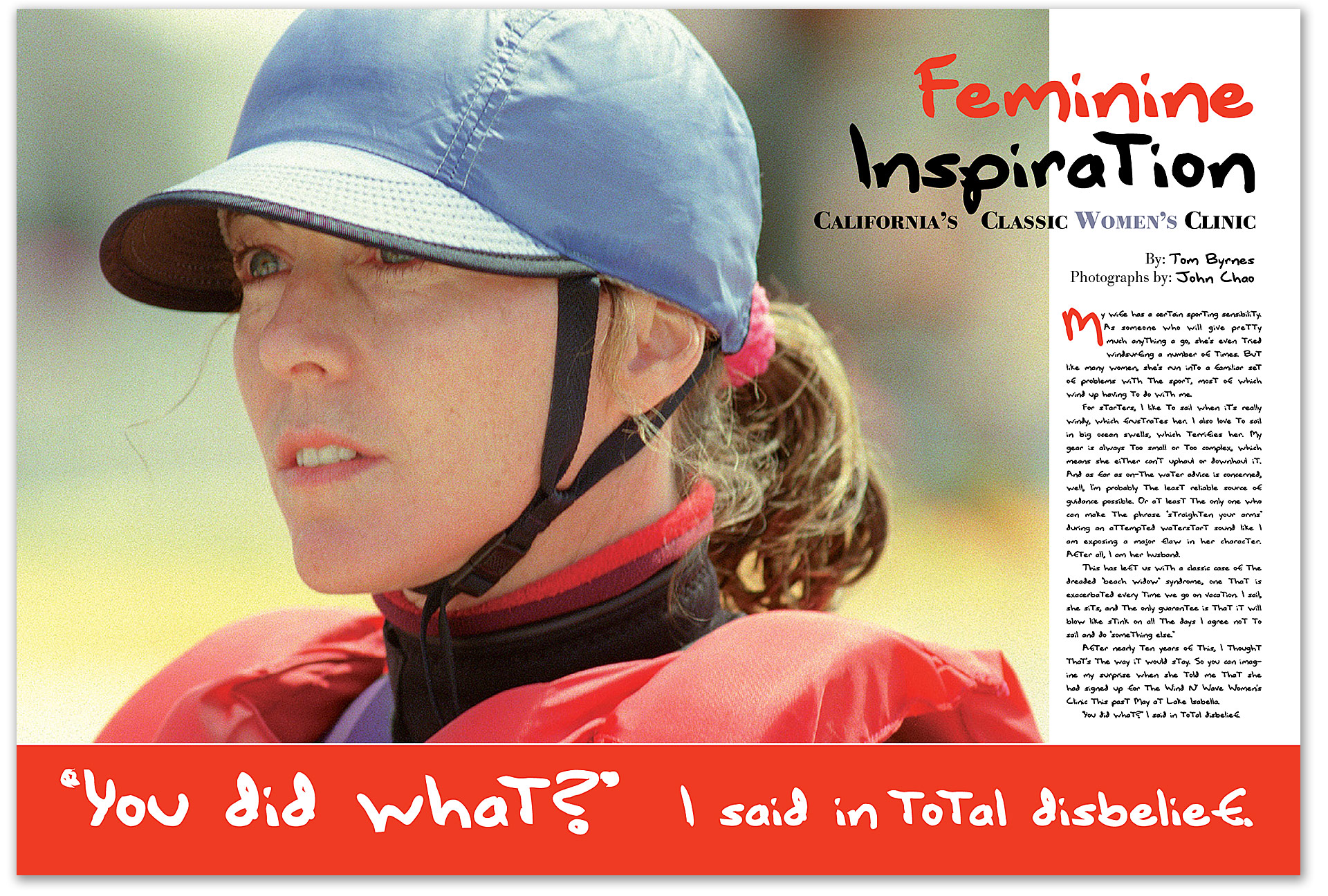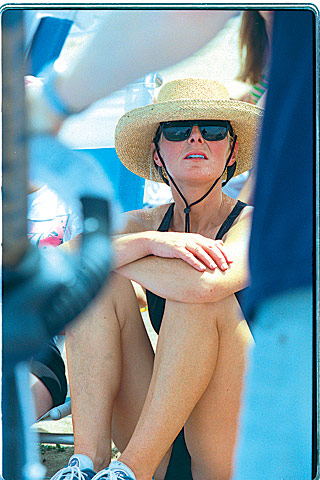
MY WIFE has a certain sporting sensibility. As someone who will give pretty much anything a go, she’s even tried windsurfing a number of times. But like many women, she’s run into a familiar set of problems with the sport, most of which wind up having to do with me.
For starters, I like to sail when it’s really windy, which frustrates her. I also love to sail in big ocean swells, which terrifies her. My gear is always too small or too complex, which means she either can’t uphaul or downhaul it. And as far as on-the water advice is concerned, well, I’m probably the least reliable source of guidance possible. Or at least the only one who can make the phrase “straighten your arms” during an attempted waterstart sound like I am exposing a major flaw in her character. After all, I am her husband.
This has left us with a classic case of the dreaded “beach widow” syndrome, one that is exacerbated every time we go on vacation. I sail, she sits, and the only guarantee is that it will blow like stink on all the days I agree not to sail and do “something else.”
After nearly ten years of this, I thought that’s the way it would stay. So you can imagine my surprise when she told me that she had signed up for the Wind N’ Wave Women’s Clinic this past May at Lake Isabella.
“You did what?” I said in total disbelief.
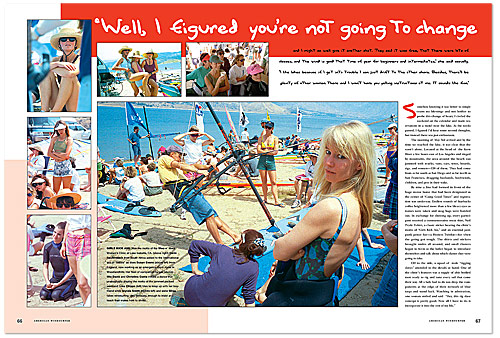
GIRLS KICK ASS: Was the motto of the Wind n’ Wave Women’s Clinic at Lake Isabella, CA. (above right) Carin Rautenbach from South Africa added to the international sea of “babes” as does Susan Evans (above left) from England, now working as an emergency room nurse in Woodlandhills. With her fleet of compatriot nurses (above) Mia Davis and Christine Costa initiate a dance that unabashedly display the motto of the jammed packed weekend. Lisa Chipps (left) tries to keep up with her boyfriend while Glynda Smith (middle left) and sister Elisa takes windsurfing very seriously, enough to insist and teach their mates how to shred.
SOMEHOW knowing it was better to simply count my blessings and not bother to probe this change of heart, I circled the weekend on the calendar and made reservations in a motel near the lake. As the weeks passed, I figured I’d hear some second thoughts, but instead there was just enthusiasm.
The morning of May 3rd arrived and by the time we reached the lake, it was clear that she wasn’t alone. Located at the head of the Kern River a few hours east of Los Angeles and ringed by mountains, the area around the beach was jammed with trucks, vans, cars, tents, boards, rigs, and women—120 of them. They had come from as far south as San Diego and as far north as San Francisco, dragging husbands, boyfriends, children, and pets in their wake.
By nine a line had formed in front of the huge motor home that had been designated as the center of “Camp Good Times” and registration was underway. Endless rounds of Starbucks coffee brightened more than a few bleary eyes as names were taken and swag bags were handed out. In exchange for showing up, every participant received a commemorative sweat shirt, Neil Pryde T-shirt, a classic sticker bearing the clinic’s motto of “Girls Kick Ass,” and an essential postpunk power bar—a Hostess Twinkie—for when the going got tough. The shirts and stickers brought smiles all around, and small clusters began to form as the ladies began to introduce themselves and talk about which classes they were going to take.
Advertisement
Off to the side, a squad of male “rigging slaves” attended to the details at hand. One of the clinic’s features was a supply of able bodied men ready to rig and tune every sail that came their way. All a lady had to do was drop the components at the edge of their network of blue tarps and stand back. Watching in admiration, one woman smiled and said “Hey, this rig slave concept is pretty good. Now all I have to do is incorporate it into the rest of my life.”
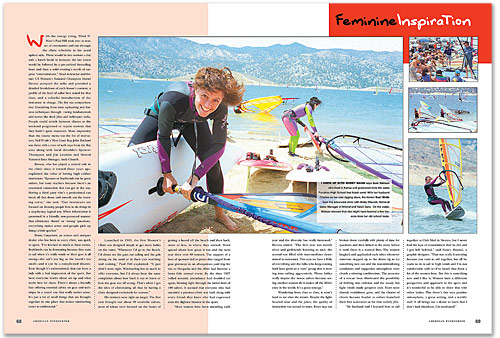
I GREW UP WITH ROBBY NAISH says Susi Watson who lived in Kailua and graduated from the same Punahou High School that Naish went. With her husband Charles as her own rigging slave, the former Susi Wells took the advanced clinic with Andy Church, National Sales Manager of Mistral and Naish Sails. On the water, Watson showed that she might have learned a few lessons from her old school mate.
WITH THE ENERGY RISING, Wind N’ Wave’s Paul Hill took over as master of ceremonies and ran through the clinic schedule in his usual upbeat style. There would be two sessions a day with a lunch break in between; the last lesson would be followed by a pre-cocktail freesailing hour and then a solid evening’s worth of surprise “entertainment.” Head instructor and former US Women’s National Champion Mariel Devesa accepted the mike and provided a detailed breakdown of each lesson’s content, a profile of the level of sailor best suited for that class, and a colorful introduction of the instructor in charge. The list was comprehensive: Everything from basic uphauling and harness techniques through racing fundamentals and moves like duck jibes and helicopter tacks. People could switch between classes as the weekend progressed or repeat sessions that they hadn’t quite mastered. More impressive than the course menu was the list of instructors. Neil Pryde’s West Coast Rep John Burhani was there with a crew of tech reps from the Bay area along with local shredders Spencer Thompson and Jim Leotinis and Mistral National Sales Manager, Andy Church.
Devesa, who has played a central role in the clinic since it started three years ago, explained the value of having high caliber instructors. “Spouses or boyfriends can be great sailors, but lousy teachers because there’s an emotional connection that can get in the way. Having a third party who’s a professional can break all that down and smooth out the learning curve,” she said. “Our instructors are focused on showing people how to do things in a step-by-step logical way. When information is presented in a friendly, non-pressured manner that eliminates ‘dumb’ or ‘wrong’ questions, everything makes sense and people pick up things a little quicker.”
Diane Carpenter, an actress and antiques dealer who has been to every clinic, was quick to agree. “I’ve learned so much at these events. Boyfriends can be frustrating because they want to sail when it’s really windy or their gear is all wrong—the sail’s too big or the board’s too small—and it can be a complicated disaster. Even though it’s unintentional, that can leave a lady with a bad impression of the sport. But here everyone learns about set up and what works best for them. There’s always a friendly face offering essential advice on gear and technique in a casual way that really makes sense. It’s just a lot of small things that are brought together in one place that makes windsurfing easier to understand.”
Launched in 1995, the first Women’s Clinic was designed simply to get more ladies on the water. “Whenever I’d go to the beach, I’d always see the guys out sailing and the gals sitting on the sand or in their cars watching and waiting,” Paul Hill explained. “It just didn’t seem right. Windsurfing has so much to offer everyone, but I’d always hear the same complaints about how hard it was to learn or how the gear was all wrong. That’s when I got the idea of eliminating all that by having a clinic designed exclusively for women.”
His instincts were right on target. The first year brought out about 30 would-be sailors, most of whom were focused on the basics of getting a board off the beach and then back, more or less, to where they started. Word spread about how great it was and the next year drew over 60 women. The support of a host of sponsors led to prizes that ranged from gear giveaways to an all-expenses paid trip for two to Margarita and the clinic had become a bona fide annual event. By the time 1997 rolled around, attendance had doubled yet again, blowing right through the initial limit of 100 sailors. It seemed that everyone who had attended a previous clinic was back along with every friend they knew who had expressed even the slightest interest in the sport.
“More women have been attending each year and the diversity has really increased,” Devesa added. “The first year was mostly wives and girlfriends learning to tack; the second was filled with intermediates determined to waterstart. This year we have a little of everything and the folks who keep coming back have given us a ‘core’ group that is moving into sailing aggressively. Those ladies really inspire the newer sailors because seeing another woman do it makes all the difference in the world. It’s a great synergy.”
Wandering from class to class, it wasn’t hard to see what she means. Despite the lighthearted tone and the jokes, the quality of instruction was second to none. Every step was broken down carefully with plenty of time for questions and then linked to the move before it until there is a natural flow. The women laughed and applauded each other whenever someone stepped up to the demo rig to try something new out and the non-intimidating conditions and supportive atmosphere were clearly a winning combination. The presence of a rescue boat eliminated the possibility of drifting into oblivion and the steady but light winds made progress easy. Fears were shared, confidence grew, and the chorus of cheers became louder as sailors launched their first waterstart or hit that wobbly jibe.
“My husband and I learned how to sail together at Club Med in Mexico, but I never had the type of commitment that he did and I got left behind,” said Nancy Hoanzl, a graphic designer. “That was really frustrating because you want to sail together, but all he wants to do is sail in high winds and I’m not comfortable with it—I’ve heard that from a lot of the women here. But this is something new and I like it. Women have a different perspective and approach to the sport and it’s wonderful to be able to share that with other ladies. Plus there’s this very positive atmosphere, a great setting, and a terrific staff. It all brings out a desire to learn that I don’t find elsewhere. I’m motivated!”
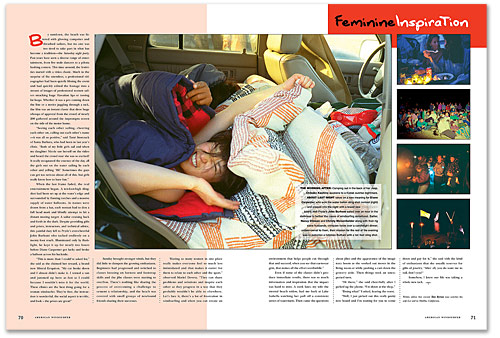
THE MORNING AFTER: Camping out in the back of her Jeep, Chikako Kashino awakens to a Kodak sunrise nightmare. ABOUT LAST NIGHT takes on a new meaning for Diane Carpenter who won the water ballon sling shot contest (right) and slipped into the night with a brand new Mistral Eruption board. Neil Pryde’s John Burhani sailed over an hour in the darkness to further the cause of windsurfing sisterhood. Earlier, Nancy Dimson and Christy Meisenhelder along with their rig slave husbands, compare notes over a candlelight dinner, unbeknownst to them, their mission for the rest of the evening was to pulverize a helpless Burhani with a ten foot sling shot.
BY SUNDOWN, the beach was littered with glowing campsites and thrashed sailors, but no one was too tired to take part in what has become a tradition—the Saturday night party. Past years have seen a diverse range of entertainment, from live male dancers to a pi˜nata bashing contest. This time around, the festivities started with a video classic. Much to the surprise of the attendees, a professional videographer had been quietly filming the event and had quickly edited the footage into a stream of images of professional women sailors smacking huge Hawaiian lips or tossing fat loops. Whether it was a pro coming down the line or a novice juggling through a tack, the film was an instant classic that drew huge whoops of approval from the crowd of nearly 200 gathered around the impromptu screen on the side of the motor home.
“Seeing each other sailing, cheering each other on, calling out each other’s name —it was all so positive,” said Tami Storczack of Santa Barbara, who had been to last year’s clinic. “Both of my little girls sail and when my daughter Nicole saw herself on the video and heard the crowd roar she was so excited! It really recaptured the essence of the day, all the girls out on the water sailing by each other and yelling ‘Hi!’ Sometimes the guys can get too serious about all of this, but girls really know how to have fun.”
When the last frame faded, the real entertainment began. A ten-foot-high slingshot had been set up at the water’s edge and surrounded by flaming torches and a massive supply of water balloons. As names were drawn from a hat, each woman had to don a full head mask and blindly attempt to hit a distant moving target: A sailor cruising back and forth in the dark. Despite providing gifts and prizes, instructors, and technical advice, this painful duty fell to Pryde’s ever-cheerful John Burhani who tacked endlessly on a twenty foot reach. Illuminated only by flashlight, he kept it up for nearly two hours before Diane Carpenter got lucky and broke a balloon across his backside.
“This is more than I could’ve asked for,” she said as she claimed her reward, a brand new Mistral Eruption. “My car broke down and I almost didn’t make it. I rented a van and jammed up here as fast as I could because I wouldn’t miss it for the world. These clinics are the best thing going for a woman windsurfer. They’re free, the instruction is wonderful, the social aspect is terrific, and look – the prizes are great!”
Sunday brought stronger winds, but they did little to dampen the growing enthusiasm. Beginners had progressed and switched to classes focusing on harness and footstrap skills and the jibe classes were starting to overflow. There’s nothing like sharing the process of overcoming a challenge to cement a relationship, and the beach was covered with small groups of newfound friends sharing their successes.
‘Having so many women in one place really makes everyone feel so much less intimidated and that makes it easier for them to relate to each other and the sport,” observed Mariel Devesa. “They can share problems and solutions and inspire each other as they progress in a way that they probably wouldn’t be able to elsewhere. Let’s face it, there’s a lot of frustration in windsurfing and when you can create an environment that helps people cut through that and succeed, when you see that ear-to-ear grin, that makes all the effort worthwhile.”
Advertisement
Even if some of the classes didn’t produce immediate results, there was so much information and inspiration that the impact was hard to miss. A week later, my wife the eternal beach widow, had me back at Lake Isabella watching her pull off a consistent series of waterstarts. Then came the questions about jibes and the appearance of the imaginary boom as she worked out moves in the living room or while pushing a cart down the grocery aisle. Then things took an unexpected turn.
“Hi there,” she said cheerfully after I picked up the phone. “I’m down at the shop.”
“Doing what?” I asked, fearing the worst.
“Well, I just picked out this really pretty new board and I’m waiting for you to come down and pay for it,” she said with the kind of enthusiasm that she usually reserves for gifts of jewelry. “After all, you do want me to sail, don’t you?“
Somehow, I knew our life was taking a whole new tack.


